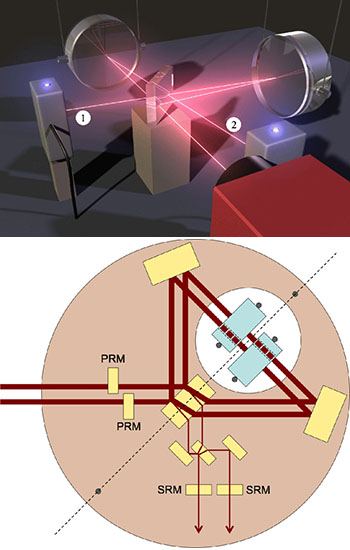
(Top) In a Michaelson interferometer setup for generating EPR entanglement, radiation pressure from laser light leads to motion and, ultimately, entanglement of two suspended mirrors. (Bottom) The new, modified experimental arrangement proposed by Schnabel would suspend the test mirrors (blue rectangles) in close proximity, and strike them with laser light front and back, thereby allowing classical noise to be canceled from the system. [Images: Schnabel, Phys. Rev. A, doi: 10.1103/PhysRevA.92.012126]
Last week in this space, we covered a recent paper in Optica that reported work with entanglement of classical light fields, and suggested that a famous “litmus test” of quantum behavior, the Bell inequality, might need a rethinking. Now, Roman Schnabel, a scientist at the University of Hanover, Germany, has proposed a creative experiment that would explore the limits of entanglement of another kind—the fleeting, quantum entanglement of two massive (0.1-kg) macroscopic objects (Phys. Rev. A, doi: 10.1103/PhysRevA.92.012126). And the experimental setup, he suggests, might also, as a by-product, allow for a test of certain tantalizing models of quantum theory that include gravity.
EPR paradox, again
As with the previously reported paper in Optica, Schnabel’s proposal has its roots in the celebrated 1935 work by Albert Einstein, Boris Podolsky and Nathan Rosen—known forever after by the acronym “EPR.” That study argued that the ostensibly implausible, “spooky” prediction of entanglement of quantum particles at a distance suggested that quantum theory itself was incomplete.
Since then, experimentalists have demonstrated quantum entanglement on a microscopic level across a wide range of systems, from photons and atoms up to micrometer-scale oscillators, a finding that has given the nod to quantum completeness after all. The same studies have also led physicists to wonder if quantum entanglement might be detectable in much larger objects, all the way up to the kilogram scale, where “decoherence effects” attributable to macroscopic motion and environment can easily wipe out delicate quantum correlations.
One possible laboratory for such macroscopic entanglement, Schnabel and colleagues have proposed in previous work, could be large-scale, laser-interferometric gravitational-wave detectors such as LIGO. In these facilities, the sensitivities are sufficiently high that EPR-entangled motion of the detectors’ massive mirrors might be generated and measured. But while possible in principle, retrofitting these facilities to perform macroscopic entanglement experiments would be something of a challenge.
A “better mousetrap” for macroscopic entanglement
Building on that previous work, Schnabel has now proposed a new experimental setup to achieve such macroscopic entanglement. While based, like previous proposals, on straightforward Michelson interferometry, Schnabel’s setup would leverage the experimental geometry to cancel out classical noise.
Specifically, the setup involves two high-quality laser mirrors, suspended as pendula, as the objects of entanglement (top diagram at right). Radiation pressure from laser light leads to entanglement between the motion of the mirrors and the laser light field, which is transferred into mirror-mirror EPR entanglement through detection and measurement of interference at two output points.
The modified setup proposed by Schnabel (bottom diagram at right), however, includes an important modification. While the two 0.1-kg mirrors still constitute the end mirrors of a Michelson interferometer, they are placed side by side (blue rectangles in schematic) rather than at a distance, and in such a way that they reflect laser energy both from the front and the back. The geometry effectively cancels out classical radiation-pressure fluctuations in the laser, allowing for a cleaner interferometric signal of quantum entanglement of the two massive objects.
A test of quantum gravity?
Schnabel also notes that the close alignment of the mirrors affords a possible test of some theories that are attempting to unify quantum mechanics and gravity. That’s because the action of gravity should introduce decoherence into the system’s motion, which would be expected to erase the macroscopic quantum entanglement on a specific, predictable timescale. The placement of the entangled mirror masses in such close proximity could allow for sufficient gravitational energy to make that decoherence detectable—and provide, potentially, a useful platform to test candidates for the long-sought “Theory of Everything.”
